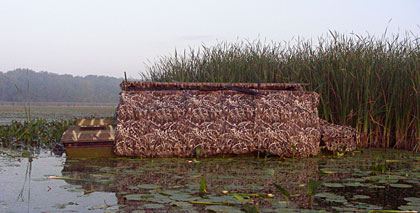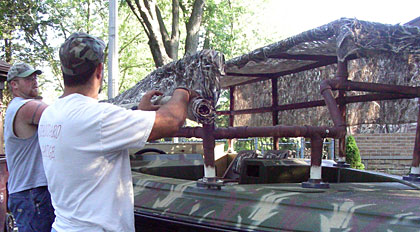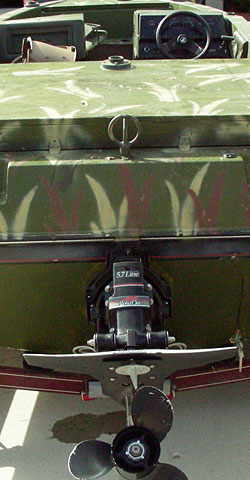January 01, 2017
By Mike Marsh

Advertisement
|
Advertisement
Not many people can look at a high-powered ski boat and imagine transforming it for higher use as a duck boat. But Shane Maier and Ryan Jordan of Illinois succeeded in doing exactly that.
For overall ingenuity and foresight, their entry, "The World's Fastest Duck Boat," was awarded second place in the 2009 Wildfowl Boats and Blinds Contest, sponsored by FA Brand, Foiles Migrators and Federal Premium Ammunition.
"Since graduating from college in 2007, my friend, Shane, and I had been looking for a boat we could transform into a duck boat," Jordan said. "Our drive to hunt is second to none. While in college at the University of Iowa, we scouted and searched local hunting lands for areas where it looked like we could kill birds. But we found our options extremely limited because we didn't have a boat.
"We were forced to hunt the places we could walk into, which meant trudging a half-mile at 3 a.m., carrying our guns, duck decoys, goose decoys, spinning-wing decoys and ammo bags to make sure we would arrive at the best hunting spot before someone else beat us to it."
After graduation, Jordan moved back to his hometown of Antioch, Ill., and Maier, an Iowa native, moved to Northbrook, Ill., about 40 minutes south of Antioch. They spent the entire 2008 hunting season hunting out of a makeshift blind that was nothing more than some leafy camouflage material wrapped around four pier poles.
"We only killed two ducks out of that blind," Jordan said. "There were no chances to shoot. Our calling brought the ducks in to have a look, but they flared once they got close. We needed a better blind."
In summer 2009, fortune smiled on the dedicated duck hunters.
"Our college track coach had a summer cottage in Antioch that he wanted cleaned out," Jordan said. "Shane and I offered to help gut the house and get it ready to be sold. When we got there, we noticed a boat in the driveway. It was a ski boat covered with a ragged, torn tarp. It was overgrown with weeds and surrounding trees. After working on the house for two days, our coach told us to look at the boat and take it if we wanted it."
The hunters' eyes lit up at the thought. They might have finally found their duck boat.
"We took off the tarp to get a better look at the boat," Jordan said. "The boat was in shambles. We found out the boat was a 1989 Invader V187, which is an 18-foot inboard/outboard ski boat. Various animals had inhabited the boat over the nine years it had sat dormant in the driveway."
 Shane Maier and Ryan Jordan used easy-to-cut PVC piping to form the skeleton for a blind to top the "World's Fastest Duck Boat." |
Only a duck hunter could have seen potential in the boat. Raccoon droppings littered the floor, seats and engine compartment. A dead squirrel had found its final resting place beneath the driver's side console. Animals had ripped the seats to shreds to make nests throughout the boat. All the seat cushions were ripped, soaked and stained. Mold grew everywhere.
"To say it was a disaster is an understatement," Jordan said. "The one gleaming beacon we found when we lifted the motor cover. When we opened the hood, we found a 5.7L Mercruiser engine with an Alpha One outdrive. The combination of the low-profile nature of a ski boat and the massive 250-horsepower engine was an opportunity we decided we could not pass up. Our coach signed the boat title over to me, and we started cleaning it out. We were lucky to have a Dumpster already on the site."
The first step to creating a dream duck boat from a nightmare was to gut the craft. They removed everything, from the windshield down to the carpet. They undid every screw and stripped every part until all that remained was a fiberglass shell. The trailer could not even be moved until a ruined tire was replaced. On its first trip in nine years, the boat made its first stop at a car wash.
"We power-washed all the feces out of the inside and all the vegetation that had grown on the outside of the boat," Jordan said. "After giving the boat a bath, we were ready to start the real work, which was getting the engine running and building a blind."
A new coil and fuel pump brought the engine into proper running order. They also replaced the bilge pump. Making the hull shipshape was an entirely different matter.
 The 1989 ski boat, powered by a 250 hp inboard motor, was painted camouflage using cardboard stencils. |
Jordan and Maier filled screw holes that attached the windshield, guard rails, wood molding and other trim with two coats of fiberglass resin, and then sanded the entire boat.
"After sanding, we primed the boat to get it ready for painting," Jordan said. "We used a deck paint and added sand to make sure we would have traction when the boat became wet and icy late in the hunting season. We painted the deck and top portion above the water first. After three coats of paint, we applied a base paint color. Then, we cut out a cardboard stencil. Using both sides of the stencil and three different spray paint colors, we created an overlapping grass camouflage. This was a very simple process and created a perfect break-up pattern."
After taking measurements, the duo built a custom rear bench that acts as a firewall for the engine compartment, hides the 20-gallon fuel tank and serves as the rear seat support. A piano hinge installed on the starboard side of the bench allows it to open into the center of the boat, which permits access to storage space beneath.
"The seats were then installed using carriage bolts," Jordan said. "The seats were attached to low-profile swivel mounts. Four coarse-thread screws, which came with the seats, attached each swivel mount to the seat, and the carriage bolts anchored the seat to the plywood."
Another seat attached to the port side compartment cover in the open bow section of the boat. All compartment covers used piano hinges for durability, and a swivel mount secured the driver's seat. But Jordan and Maier added a 12-inch pe
destal to the driver's seat swivel to elevate the driver to increase visibility while the boat is underway. They also built a new engine cover out of plywood, painted it to match the camouflage scheme of the rest of the boat and installed it.
Erecting the blind skeleton was next on the agenda. One-and-a-half-inch PVC pipe formed the skeleton because it is durable, inexpensive, readily available and easy to cut and fit together.
"I sketched the main layout of the blind in just a few minutes to establish how much PVC pipe we would need and what kinds of fittings we would need," Jordan said. "We constructed the skeleton in two sections: the port or back side of the blind and the starboard or front side of the blind. The sections are connected by two 7/16-inch clevis pins and hitch pin clips, one in the bow and one in the stern. The blind is attached to the boat by 10 1½-inch PVC flanges. The flanges are each connected by two …œ-by-3-inch hex bolts. The skeleton was painted with brown camouflage spray paint, but any natural color would have worked, as long as it was flat paint."
Two different types of fabric covered the blind. Jordan and Maier considered two critical factors when selecting the materials -- concealment and weather protection.
"We decided to use camouflage burlap for the base covering and add leafy material on top of the burlap," Jordan said. "We used brass grommets to connect the two materials. The grommets create a connection that will not tear. Grommets were placed every 18 inches along the blind. The blind material is attached only to the inside of the skeleton, allowing the material to be rolled up for transportation and storage."
The width of the material was not adequate to reach the boat from the rear of the blind skeleton. Therefore, the hunters used burlap twine switched together for two sections to cover the rear of the blind.
"The front and rear of the blind each took two full sheets of 12-foot by 54-inch blind material," Jordan said. "To the bottom of the material, we attached 2-foot sections of painted PVC to add weight and keep the material from blowing too much in the wind. The final step was covering the sides of the blind (bow and stern), which were attached in the same fashion as the front and rear of the blind, except that they cannot be rolled up."
The floor and bench surfaces were carpeted to improve traction and allow quiet movement. Practicality trumps everything else -- even in a duck boat with a 250-hp V-8 power plant.
"The entire blind cost less than $300 and took only two weekends to complete," Jordan said. "The blind can be rolled up, the pins disconnected and removed from the boat in two pieces in less than a minute. The blind weighs less than 50 pounds."
The boat has proved effective: The hunters took 24 geese in four hunts during early goose season.
As for the boat's claim to be "The World's Fastest Duck Boat," challengers are certainly welcome to vie for the title. But they'll have to stoke up on horsepower to beat a "scouting" speed of 50 mph and a top speed of more than 65 mph.
